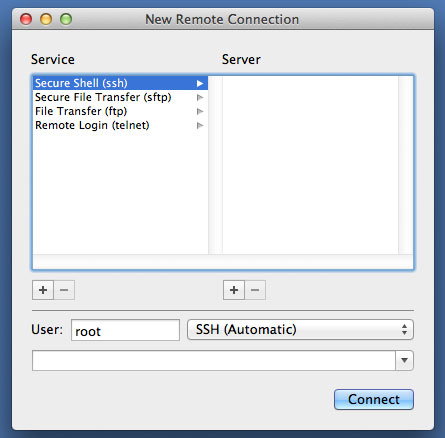

- #PUTTY FOR MAC CONNECT SSH KEY INSTALL#
- #PUTTY FOR MAC CONNECT SSH KEY WINDOWS 10#
- #PUTTY FOR MAC CONNECT SSH KEY SOFTWARE#
- #PUTTY FOR MAC CONNECT SSH KEY PASSWORD#
- #PUTTY FOR MAC CONNECT SSH KEY FREE#
You will be asked to enter the sudo user’s username to log into the server and the passphrase for the public key you specified at the generation step. If you click Accept, the next time you connect, you won’t be asked this question again. PuTTY will ask you to confirm if you would like to cache the server’s host key to your local registry. You can then click Open to start the SSH session, which opens a terminal window. Then, navigate to Connection > SSH > Auth under the “Category” tree on the left-hand side of the PuTTY screen.Ĭlick the Browse button, and select the id_rsa.ppk file you saved from PuTTYgen. If you have already configured your DNS and the domain name is pointing to the server, you can use that here. Open PuTTY and enter the server’s IP address in the “Host Name” field. Once you have added your public key to your SpinupWP server and assigned it to a sudo user, you can set up PuTTY to SSH into the server. When adding the public key, use the contents of the PuTTYgen “Public key” text area or use the contents from the public key file if you saved it at the previous step. Add the Public Key to Your Spinupwp Sudo Userīefore you can connect to the server, you will need to add the public key you just generated to your server, and then attach it to a sudo user. You can also click the Save public key button to save the public key to a local file, but this is unnecessary. If you need someone else to access your server, follow the steps in this doc to create a separate private key for them.
#PUTTY FOR MAC CONNECT SSH KEY PASSWORD#
Your private key file should be treated as you would a password and never shared with anyone. You can save this anywhere on the computer, either on your desktop or in your Documents folder. You’ll use the passphrase when you authenticate using this key.įirst, click the Save private key button, and store the private key as id_rsa.ppk. At this point, it’s a good idea to enter and confirm a “Key passphrase”. Once the key generation has completed, PuTTYgen will populate the “Public key”, the “Key fingerprint”, and the “Key comment” values. PuTTYgen will ask you to move the mouse over a selected area to generate the key. For increased security, we recommend increasing this value to 4096.Ĭlick Generate. On Windows 10, PuTTYgen defaults to generating an RSA key of 2048 bits.

#PUTTY FOR MAC CONNECT SSH KEY WINDOWS 10#
The quickest way to run PuTTYgen on Windows 10 is to click the Start button, type putty, and then select “PuTTYgen” from the results. PuTTY has a bundled PuTTYgen application that allows you to generate your public and private keys.
#PUTTY FOR MAC CONNECT SSH KEY INSTALL#
To get PuTTY, browse to the download page and download and install the latest version.

However, you can use an application called PuTTY to generate an SSH key and use it to connect to your server’s command line. Unlike macOS or Linux-based distributions, Windows does not come with a built-in terminal application that you can use to access an Ubuntu server via SSH, using public/private key authentication. I gave SSH Tunnel Manager a shot, but it doesn't appear to support the use of SSH keys.Connect to Your Server via SSH on Windows
#PUTTY FOR MAC CONNECT SSH KEY FREE#
I'd also be happy to try another program if a free one is available for Mac. PuTTY will automatically try to authenticate using any keys currently loaded in Pageant. Just enter your hostname or IP address, and SSH user. You don’t have to take any extra steps in PuTTY. Notably, even if I create the SSH private/public key without a passphrase, I still get prompted for a password-this same key works fine in Windows with Putty without a passphrase.Ĭan somebody help me understand what I'm doing incorrectly? It's very puzzling to me how the same key that works in Putty is not working in Terminal. Step 2 Connecting to the Server (s) Now these keys will be available while connecting to any server during your PuTTY sessions. When I enter the passphrase for the key, access is denied.
#PUTTY FOR MAC CONNECT SSH KEY SOFTWARE#
Debug1: Reading configuration data /etc/ssh_configĭebug1: Connecting to 33.222.33.222 port 22.ĭebug1: identity file /Users/user/.ssh/privatekey.ppk type -1ĭebug1: identity file /Users/user/.ssh/privatekey.ppk-cert type -1ĭebug1: Remote protocol version 2.0, remote software version OpenSSH_5.9p1 Debian-5ubuntu1ĭebug1: match: OpenSSH_5.9p1 Debian-5ubuntu1 pat OpenSSH*ĭebug1: Enabling compatibility mode for protocol 2.0ĭebug1: Local version string SSH-2.0-OpenSSH_5.6ĭebug1: kex: server->client aes128-ctr hmac-md5 noneĭebug1: kex: client->server aes128-ctr hmac-md5 noneĭebug1: No more authentication methods to try.


 0 kommentar(er)
0 kommentar(er)
